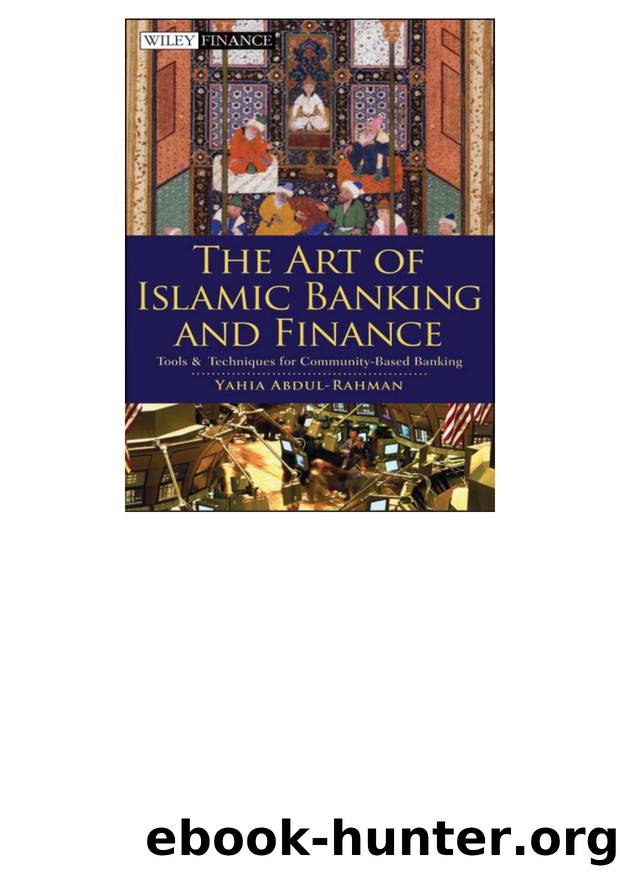The Art of Islamic Banking and Finance by Yahia Abdul-Rahman

Author:Yahia Abdul-Rahman [Abdul-Rahman, Yahia]
Language: eng
Format: epub
Published: 2010-05-10T16:00:00+00:00
CHAPTER 8
What Is the Difference?
Comparing Riba-Free Banking and Conventional Riba-Based Banking
THE RF BANKING BRAND: HISTORY, DEVELOPMENT, AND STAGES OF GROWTH
Riba is prohibited in Judaism, Christianity, and Islam (as detailed in Chapter 2). The riba-free (RF) banking system was started in the time of the Prophet Muhammad (pp); it reinforced the teachings of Moses (pp) and Jesus (pp) in the seventh century and helped the growth of international trading, but it declined over the years and was dismantled completely after World War I and the disassembly of the Ottoman Empire. The RF banking and finance system was left behind as the riba-based banking system grew and developed in a more sophisticated way to meet the ever-growing volume and diversity of world economy and trade. New economic, monetary, political, and social systems were developed in Europe to cope with the changes of the Renaissance and, later, the Industrial Revolution. After World War I, most the Muslim lands were occupied by the British and the French. It is believed by some that this was Godâs plan to wake up the people of these lands, to expose them to the Western world and bring them quickly to the latest developments of the 19th and early 20th centuries. As a result, many young men and women were educated and became aware of the new world and its progress in the fields of education, medicine, social relations, and science. A new generation of more educated and sophisticated Muslim leaders came in contact with Europe and began dreaming of catching up with its progress. At the same time, many Muslim religious leaders were sent to Europeâmainly to France and Englandâto obtain higher education and get exposed to the lifestyle and culture there. These students were sent from Egypt and India (now India, Pakistan, and Bangladesh). Many were graduates from religious schools such as Al Azhar (the oldest Islamic seminary and university in the world) and other religious schools in India. They obtained post-graduate degrees from the leading universities in Europe and went back to their countries, aspiring to build the future by telling people what they had seen and how they had lived, sharing their experiences and dreams about the future of their land. They started motivating people to work hard in order to catch up with Europe and its Renaissance. They were positioned in responsible posts in the government, such as the ministry of education (to develop a better education system for the future generations) and the ministry of finance (to help streamline and plan state finances and budgets). Many became famous newspaper editors and authors of books in general and about Islam and Prophet Muhammad (pp), using a new research-based approach with documentation and analysis in the way they had learned in Europe. Many of them started new political and civic movements to bring back the long-forgotten glory of the teachings of Islamâwhich is called in this book the Judeo-Christian-Islamic value system.
One of the first books I read back in 1964 was a small paperback titled Bonook Bela Fawaâed, which means âbanks without interest.
Download
This site does not store any files on its server. We only index and link to content provided by other sites. Please contact the content providers to delete copyright contents if any and email us, we'll remove relevant links or contents immediately.
The Fifteen Biggest Lies about the Economy: And Everything Else the Right Doesn't Want You to Know about Taxes, Jobs, and Corporate America by Joshua Holland(1087)
The Economist (20210109) by calibre(897)
The World For Sale by Javier Blas(821)
Made in China by Anna Qu(812)
Philippines--Culture Smart! by Culture Smart!(669)
Boom and bust a global history of financial bubbles by Quinn William Turner John(656)
Mission Economy by Mariana Mazzucato(654)
Forex Trading All In One For Dummies by Mishra Mamta(640)
Big Money by Kenneth P. Vogel(624)
The Money Revolution by Anne Boden(618)
The Dictatorship of Woke Capital by Stephen R. Soukup(615)
The New Retirement Savings Time Bomb by Ed Slott(603)
Tax the Rich! by Morris Pearl(598)
Cross Winds: Adventure and Entrepreneurship in the Russian Far East by Myers Steven(592)
The Inflation Myth and the Wonderful World of Deflation by Mark Mobius(586)
Fundamentals of Finance by Mustafa Akan Arman Teksin Tevfik(562)
The Great Demographic Reversal by Charles Goodhart & Manoj Pradhan(554)
European Yearbook of International Economic Law 2017 by Marc Bungenberg Markus Krajewski Christian Tams Jörg Philipp Terhechte & Andreas R. Ziegler(550)
Business Recoded by Peter Fisk(542)
